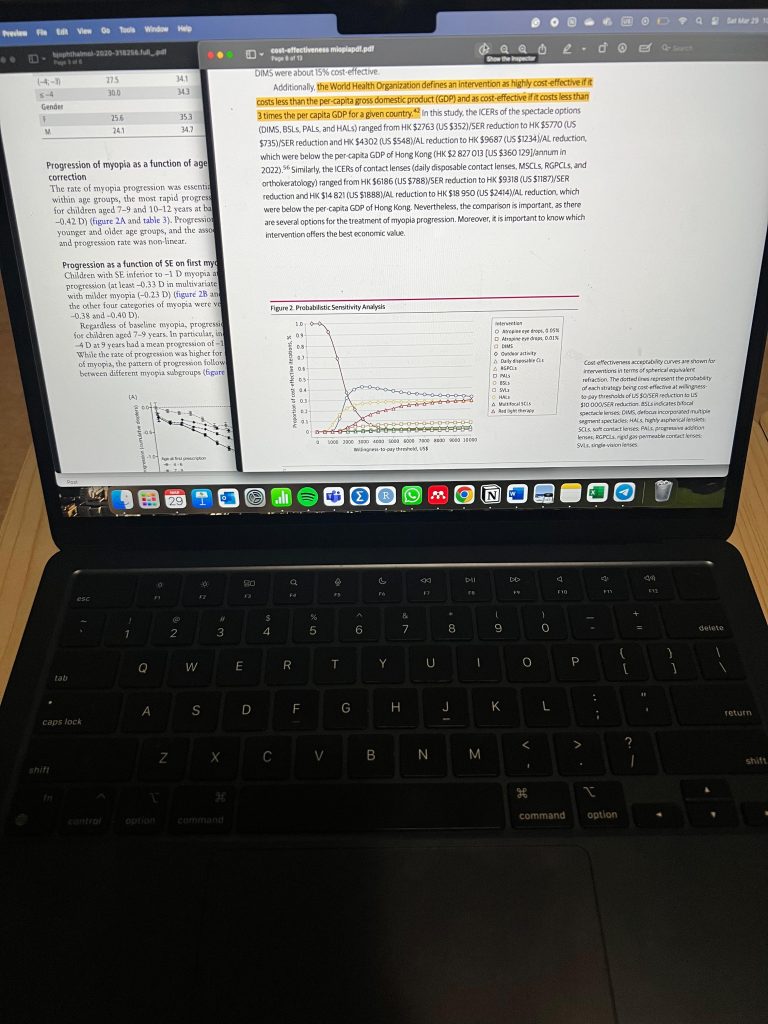
A day in the life of a health econ thesis: Excel and modeling
Dear HEPMers and curious minds, I am modelling! In this blog, I’m sharing a sneak peek into what it’s like to write a thesis in health economics at Karolinska Institutet.
Since I’m working on a health economics evaluation project, expect to find me deep in Excel sheets, building decision trees, checking cost-effectiveness thresholds and, yes, running on too much coffee.
So here’s a day in the life of a HEPM thesis project: what I’m doing, what I’m learning, and how it’s shaping my next career steps.
What is it on?
So when I said I started modeling, it’s not the catwalk kind. I’m talking about Excel sheets, decision trees, and cost-effectiveness analysis. My thesis evaluates an AI-based tool designed to screen for myopia (near-sightedness) in children.
The world is moving fast, and AI is becoming part of almost every aspect of our lives. Its integration into healthcare brings opportunities, but also responsibilities. If we use AI in health, we need to ensure it’s introduced in a way that’s evidence-based, affordable, and accessible to those who need it most.
On the other hand, myopia is no longer just an inconvenience—it’s a growing global burden. Its progression often continues into adulthood and, if left unaddressed, can lead to serious complications. The good news? If caught early, myopia is manageable with simple and effective treatments. That’s why early detection through tools like this AI device is so important.
From a personal standpoint, this project feels close to home. As a medical doctor who has worked in resource-limited settings, I’ve seen the gaps in early diagnosis and access to eye care. Now, in the world of health economics, I get to explore how we can evaluate and justify the use of innovative tools like this one—not just in clinical terms but also in cost-effectiveness and long-term impact.
It’s exciting to apply my new skills in modeling to a real-world health issue. And more importantly, this work contributes to helping decision-makers allocate resources wisely and make interventions available to the populations who need them most.
What my typical day looks like…
My typical thesis day is a mix of deep thinking, spreadsheet wrestling, and way too many cups of coffee. Most days, I work from home, but sometimes, I switch it up and head to the KI library or Solna Bibliotek. And yes, cafes are always a vibe especially when you need a change of scenery (or just a pie).


My mornings usually start with…you guessed it, a cup of coffee. I begin with a literature review, reviewing papers and textbooks to better understand the theoretical parts of health economics. Once that’s done, the rest of the day is dedicated to building (or debugging) my model in Excel and R using the inputs I gathered earlier.
Since I am working on a hybrid model that combines a decision tree with a Markov model, I have learned that transitions both within each model and between the two require careful planning. Honestly, parameter estimation and finding the right sources are the most challenging parts. Like, your Markov model not converging while your coffee does? Relatable.
If someone handed me all the data, I swear I could build the model in a few days. But hey, the digging, reading, and trial-and-error are where the real learning happens.
Throughout the day, I take breaks—go for a short walk (if the weather is nice), cook something simple, or watch YouTube videos on health economics modelling (shoutout to all the creators). I also sometimes revisit our recorded classes to refresh what we learned last year.
Special mention to our professor, George Keel—every exercise we did in his classes is now solving big problems for me in real life. (take a note here)

Evenings are usually slower. I use that time to respond to emails and write a short summary or reflection of the day. It helps me pick up right where I left off the next morning.
The learning curve
So far, the learning curve has actually been smoother than I expected. Mostly because I’m genuinely interested in the topic. But I’ve also had a few surprises along the way.
For starters, I used to think that health economic evaluation was mainly about crunching numbers and reporting outcomes. But it turns out it’s so much more strategic than that. It’s not just a one-time analysis, it’s a tool that can (and should) evolve. You can revisit it, update it, and even build on it as new evidence, treatments, or technologies emerge. It becomes part of a larger decision-making ecosystem for both healthcare sector and manufacturers. And that means the way we build these models has to be robust, detailed, and open to future refinements.

Another unexpected bonus? This thesis has pushed me to develop skills I probably would’ve avoided otherwise. Let’s be real, many of us in healthcare tend to shy away from Excel, R, VBA, or SPSS. It’s almost a phobia.
But not anymore (at least for me). If you’re thinking about focusing on health economics during your HEPM programme, don’t worry about being an expert right away. Use your thesis as an opportunity to teach yourself practical skills bit by bit. You’ll be surprised how far you can go with curiosity, your health econ class, a few YouTube tutorials, and a supportive supervisor.
Why it matters…
As I’ve mentioned in previous blogs, your thesis isn’t just an assignment—it’s a doorway. It opens into your personal interests, the knowledge you’ve been building, and, quite possibly, your future career. If you’re planning a health economics thesis, it could lead you straight into real-life decision-making roles in health economics and outcomes research, value-based healthcare, or market access. Yes, it’s that serious.
In my case, I’ve been lucky to have Ass. Prof. Filipa Sampaio as my supervisor. She’s been pushing me (in the best way) not to settle for a basic CEA (Cost-Effectiveness Analysis), but to stretch into other parts of the process like budget impact analysis, scenario analysis and value of information.
Pro tip: Your supervisor choice is more important than your thesis title. It’s like choosing a co-pilot for a cross-country road trip… or picking the right IKEA instruction manual when you’re already halfway into building the shelf.
And yes, let’s address the not-so-glamorous side of it all. I can’t deny the Excel fatigue, the countless tabs, or the eye strain from staring at my screen too long.

Overall, this thesis journey has been incredibly rewarding so far. If you’re thinking of going the health econ route or just want to know more, feel free to reach out. I’m always happy to chat—between model debugging sessions, of course.

Yohannes - Health Economics Policy and Management
Hi there! My name is Yohannes, and I come from Ethiopia, the Cradle of Humanity. I've always been curious and ambitious, and my journey to Karolinska Institutet is a testament to that. I studied medicine and developed a deep fascination with the intersection of healthcare, economics, policy-making, and management. This passion led me to KI. I look forward to learning more about healthcare economics and becoming a part of the vibrant international community at KI. In my free time, I enjoy writing and drawing, always exploring and trying new things.

0 comments